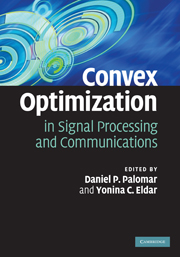Book contents
- Frontmatter
- Contents
- List of contributors
- Preface
- 1 Automatic code generation for real-time convex optimization
- 2 Gradient-based algorithms with applications to signal-recovery problems
- 3 Graphical models of autoregressive processes
- 4 SDP relaxation of homogeneous quadratic optimization: approximation bounds and applications
- 5 Probabilistic analysis of semidefinite relaxation detectors for multiple-input, multiple-output systems
- 6 Semidefinite programming, matrix decomposition, and radar code design
- 7 Convex analysis for non-negative blind source separation with application in imaging
- 8 Optimization techniques in modern sampling theory
- 9 Robust broadband adaptive beamforming using convex optimization
- 10 Cooperative distributed multi-agent optimization
- 11 Competitive optimization of cognitive radio MIMO systems via game theory
- 12 Nash equilibria: the variational approach
- Afterword
- Index
9 - Robust broadband adaptive beamforming using convex optimization
Published online by Cambridge University Press: 23 February 2011
- Frontmatter
- Contents
- List of contributors
- Preface
- 1 Automatic code generation for real-time convex optimization
- 2 Gradient-based algorithms with applications to signal-recovery problems
- 3 Graphical models of autoregressive processes
- 4 SDP relaxation of homogeneous quadratic optimization: approximation bounds and applications
- 5 Probabilistic analysis of semidefinite relaxation detectors for multiple-input, multiple-output systems
- 6 Semidefinite programming, matrix decomposition, and radar code design
- 7 Convex analysis for non-negative blind source separation with application in imaging
- 8 Optimization techniques in modern sampling theory
- 9 Robust broadband adaptive beamforming using convex optimization
- 10 Cooperative distributed multi-agent optimization
- 11 Competitive optimization of cognitive radio MIMO systems via game theory
- 12 Nash equilibria: the variational approach
- Afterword
- Index
Summary
Several worst-case performance optimization-based broadband adaptive beamforming techniques with an improved robustness against array manifold errors are developed. The proposed beamformers differ from the existing broadband robust techniques in that their robustness is directly matched to the amount of uncertainty in the array manifold, and the suboptimal subband decomposition step is avoided. Convex formulations of the proposed beamformer designs are derived based on second-order cone programming (SOCP) and semidefinite programming (SDP). Simulation results validate an improved robustness of the proposed robust beamformers relative to several state-of-the-art robust broadband techniques.
Introduction
Adaptive array processing has received considerable attention during the last four decades, particularly in the fields of sonar, radar, speech acquisition and, more recently, wireless communications [1,2]. The main objective of adaptive beamforming algorithms is to suppress the interference and noise while preserving the desired signal components. One of the early adaptive beamforming algorithms for broadband signals is the linearly constrained minimum variance (LCMV) algorithm developed by Frost in [3] and extensively studied in the follow-up literature [1, 4, 5]. Frost's broadband array processor includes a presteering delay front-end whose function is to steer the array towards the desired signal so that each of its frequency components appears in-phase across the array after the presteering delays. Each presteering delay is then followed by a finite impulse response (FIR) adaptive filter and the outputs of all these filters are summed together to obtain the array output.
Information
- Type
- Chapter
- Information
- Convex Optimization in Signal Processing and Communications , pp. 315 - 339Publisher: Cambridge University PressPrint publication year: 2009
Accessibility standard: Unknown
Why this information is here
This section outlines the accessibility features of this content - including support for screen readers, full keyboard navigation and high-contrast display options. This may not be relevant for you.Accessibility Information
- 1
- Cited by
